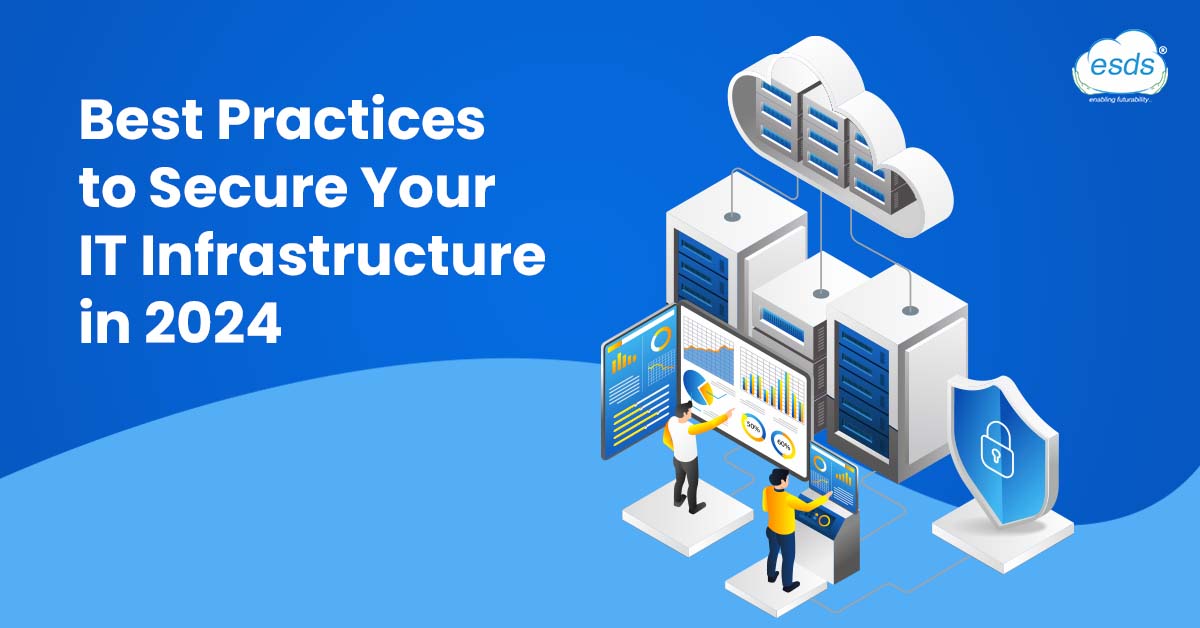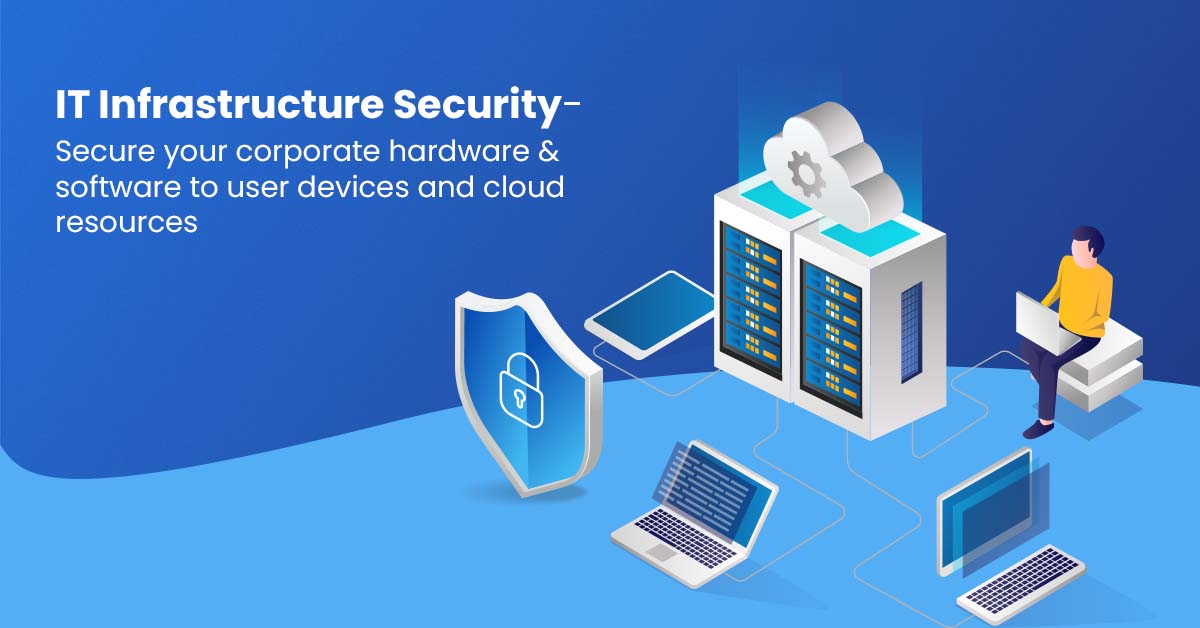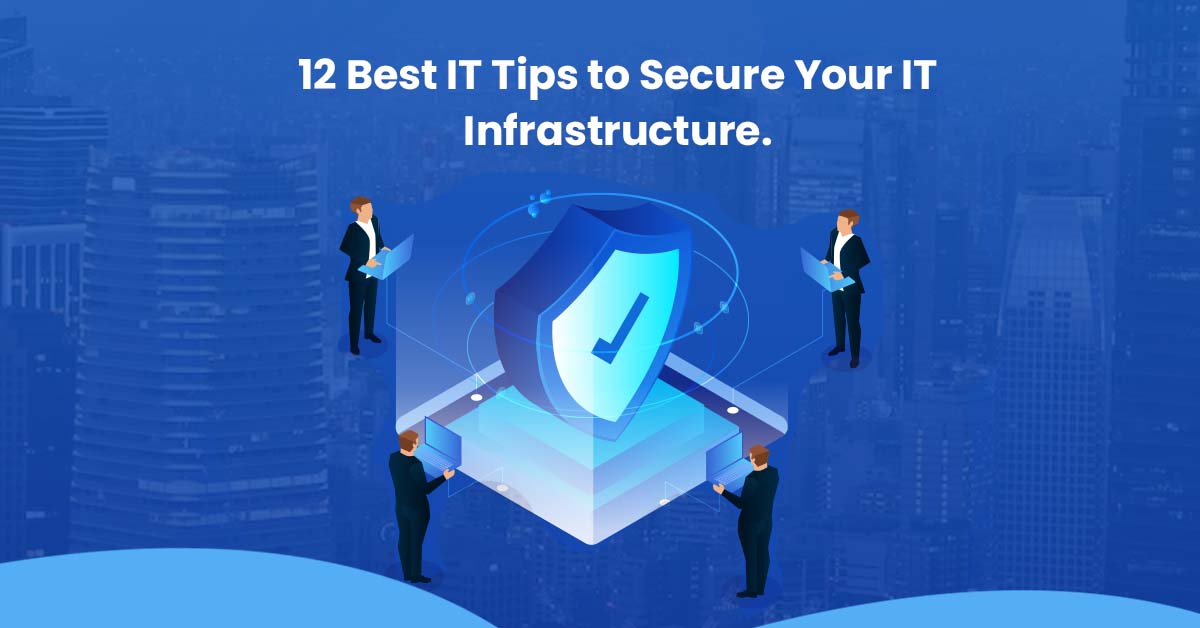12 Best Practices to Secure Your IT Infrastructure in 2024

A significant concern arises as 77% of security leaders anticipate a critical infrastructure breach in the near future. How prepared are you to secure your IT infrastructure?. Most IT security leaders foresee a major breach within an essential IT infrastructure organization, highlighting growing worries about system vulnerabilities. However, only 21% believe the government needs to be adequately prepared to respond to such violations. This data highlights the pressing need for improved cybersecurity measures and a coordinated government response to protect organization’s critical systems from potential threats.
The risks aren’t confined to large corporations alone; they extend to businesses of all sizes. Attackers are increasingly leveraging automated bots to scour the internet for vulnerabilities, making it essential for organizations to prioritize IT security.
What is IT Infrastructure Security?
IT infrastructure security encompasses the strategies and measures to safeguard your business data, mitigating the risks associated with cyber threats and data breaches. It extends its protective umbrella over various aspects, from corporate hardware and software to user devices and cloud resources.
Maintaining a trustworthy and fortified IT infrastructure is pivotal in averting potential challenges. These include the financial and operational fallout from data breaches, the disruptive impact of malicious malware on your operations and data integrity, costly system failures leading to downtime, financial setbacks resulting from data theft, ransom payouts, and recovery expenses, as well as penalties incurred for non-compliance with stringent data protection regulations.
Different levels of IT infrastructure security

1. Physical Security:
- Access Control: Implement measures to restrict physical access to data centers and server rooms.
- Surveillance: Use security cameras and monitoring systems to oversee physical access.
- Environmental Controls: Maintain suitable temperature and humidity levels to protect hardware.
2. Network Security:
- Firewalls: Deploy firewalls to control incoming and outgoing network traffic.
- Intrusion Detection Systems (IDS) and Intrusion Prevention Systems (IPS): Employ these to identify and respond to potential threats.
- Virtual Private Networks (VPNs): Enable secure remote access to the network.
3. Endpoint Security:
- Antivirus Software: Install antivirus programs on devices to detect and remove malware.
- Patch Management: Regularly update operating systems and software to fix vulnerabilities.
- Device Encryption: Encrypt data on laptops, mobile devices, and removable media.
4. Application Security:
- Secure Coding Practices: Train developers to write secure code and conduct regular code reviews.
- Web Application Firewalls (WAFs): Protect web applications from online threats.
- Regular Security Testing: Perform vulnerability assessments and penetration testing.
5. Data Security:
- Data Encryption: Encrypt data stored and in transit to protect it from unauthorized access.
- Data Backup and Recovery: Maintain regular backups and test recovery procedures.
- Data Classification: Categorize data based on sensitivity and apply appropriate security measures.
6. Cloud Security:
- Cloud Access Security Brokers (CASBs): Use CASBs to extend security policies to cloud services.
- Identity and Access Management (IAM): Manage user access and permissions in cloud environments.
- Data Loss Prevention (DLP): Prevent the accidental or intentional sharing of sensitive data.
7. Security Policies and Procedures:
- Security Policies: Develop and enforce comprehensive security policies that guide employee behavior.
- Incident Response Plan: Establish a plan to address and mitigate security incidents.
- Employee Training: Provide ongoing security awareness training to staff.
8. Compliance and Governance:
- Regulatory Compliance: Ensure compliance with industry and government regulations.
- Auditing and Reporting: Regularly audit security controls and report on their effectiveness.
- Risk Assessment: Continuously assess and mitigate risks to the IT infrastructure.
To protect your IT infrastructure, here are the 12 best IT security tips

1. Invest in User Education for IT Security
Your employees, while well-intentioned, may not have cybersecurity at the forefront of their minds. Investing in comprehensive IT security education is crucial. Provide a curriculum with practical examples and follow up with testing to ensure that IT security concepts are understood and retained.
2. Understand IT Security Threats
IT professionals should be well-versed in network and system administration but must also comprehend the various IT security threats that loom on the internet. Keep abreast of common threats such as phishing, malvertising, and browser injections by following IT security experts and organizations like OWASP.
3. Practice Good User Account Management
Implementing sound user account management practices, like two-factor authentication and regular password updates, might seem bothersome to users but is essential for IT security. Rotating passwords, requiring VPN access for external connections, and conducting compliance audits can help contain account compromises.
4. Keep Your IT Software Updated
Outdated software is a prime target for cyber attackers. Establish a routine for updating your IT software to remain current and less susceptible to exploitation.
5. Maintain Secure Backups
While backups won’t prevent IT security attacks, they can minimize the impact of such incidents. Keep backups separate from your primary network to ensure they remain uncompromised in case of a network breach.
6. Segment Your IT Network
Not all parts of your IT network are equally critical. Consider segmenting your network to restrict unnecessary interactions. For instance, create a ‘guest’ network for external connections, separating them from your core network. Focus your cybersecurity measures on the most critical components of your IT infrastructure.
7. Establish an IT BYOD Policy
In today’s world of personal devices, personal smartphones and tablets are commonplace. However, these devices pose potential threats to your network if not appropriately managed. Develop and enforce policies regarding how these devices can interact with your IT infrastructure, including access limitations, security certificate requirements, or even prohibitions.
8. Retire Old IT Devices & Services
As your organization evolves, older IT devices and services can become obsolete. Retire and remove them from your network to streamline management and reduce potential IT security vulnerabilities.
9. Test Your IT Security and IT Infrastructure
Keep your user education plan up to date as new threats emerge. Continuously test its effectiveness, ensuring that employees follow incident reporting procedures and that IT responds promptly to concerns. Consider designating a cyber hygiene trainer responsible for overseeing this crucial aspect of your IT operation.
10. Encrypt Critical IT Information
Encrypting critical data in your IT infrastructure can significantly reduce the risk of data loss in a breach. Encryption renders the content inaccessible without the appropriate keys. Prioritize encrypting your most sensitive and confidential IT information.
11. Secure Cyber-Insurance for Your IT Infrastructure
It’s impossible to eliminate 100% of cyber risk. Standard insurance policies often don’t cover data loss due to a breach. Cyber insurance is essential in protecting your organization from potential third-party liabilities and costly lawsuits in the event of an IT security incident.
12. Monitor Your IT Network(s)
Maintain constant awareness of the devices on your network. Understand how they interact with your IT infrastructure and promptly identify abnormal behavior. Your Security Information and Event Management (SIEM) system plays a pivotal role in monitoring. Address unusual activities decisively and swiftly to bolster your IT security.
To Wrap Up
Safeguarding your IT infrastructure is not an option but a necessity. Implementing these twelve IT security practices can help fortify your organization against evolving cyber threats and vulnerabilities. Stay vigilant, educate your team, and remain proactive in your IT security efforts, or Connect with ESDS for any IT security solutions!
- Decoding Generative AI: A Comprehensive Guide to Gartner’s Impact Radar - January 2, 2024
- 5 Best Practices for Cloud Security in 2024 - December 29, 2023
- 10 Best Machine Learning Ops Strategies for Cloud Environments in 2024 - December 29, 2023
